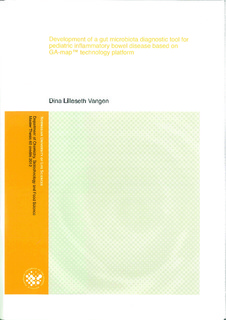| dc.contributor.author | Vangen, Dina Lilleseth | |
| dc.date.accessioned | 2012-10-12T10:12:59Z | |
| dc.date.available | 2013-09-06T23:04:10Z | |
| dc.date.issued | 2012-10-12 | |
| dc.identifier.uri | http://hdl.handle.net/11250/186454 | |
| dc.description | Oppgaven er skrevet for Genetic Analysis (GA) og inneholder informasjon som ikke skal være tilgjengelig før GA har arbeidet videre med resultater. | no_NO |
| dc.description.abstract | Inflammatory bowel disease (IBD) is an idiopathic, severe disease, which is characterized by chronic inflammation of the gastrointestinal tract. The incidence of IBD has increased through the last decades and specially among the pediatric population. The time from onset of symptoms to a final diagnose is made, is often related to delays and for many patients it is an emotionally demanding process. Early investigation in suspected cases may reduce the delay so that a treatment can begin as soon as possible. The involvement of intestinal microflora for pathogenesis of IBD is a link to further investigations to understand the disease, and to help people who suffer from IBD. The aim of the present work was to distinguish between pediatric IBD and non-IBD by identifying signatures in the microbiota. This was accomplished by use of a diagnostic tool based on GA-mapTM technology and the use of single nucleotide primer extension (SNuPE) probes to search for complementary bacterial 16S rRNA gene sequences. Seventy-four feces samples were collected from cohort and tested against 77 SNuPE probes. Statistical analysis was performed with Partial Least Squares – Discriminant Analysis and presented specificity by 82 % and sensitivity by 86 %. Classification error presented 16 % and indicated how many that was misclassified by the model. Inflammatory bowel disease is considered to include two major disorders where Crohn’s disease is one of them, and best correlation was found between Crohn’s disease and non-IBD through statistical analysis. Common bacteria that are normally shared among people with a healthy intestinal were obtained from the cohort, and as a conclusion seems an alteration of common bacteria to be involved in Crohn’s disease. | no_NO |
| dc.language.iso | eng | no_NO |
| dc.subject | innflammatory bowel diseases | no_NO |
| dc.subject | gastrointestinal diseases | no_NO |
| dc.subject | microbial flora | no_NO |
| dc.subject | diagnostic techniques | no_NO |
| dc.title | Development of a gut microbiota diagnostic tool for pediatric inflammatory bowel disease based on GA-map^TM technology platform | no_NO |
| dc.type | Master thesis | no_NO |
| dc.subject.nsi | VDP::Technology: 500::Biotechnology: 590 | no_NO |
| dc.subject.nsi | VDP::Medical disciplines: 700::Clinical medical disciplines: 750::Gastroenterology: 773 | no_NO |
| dc.source.pagenumber | 70 | no_NO |
